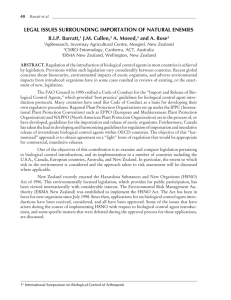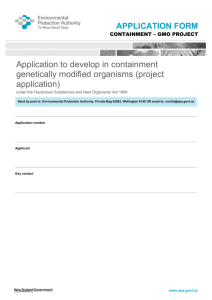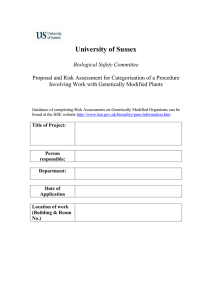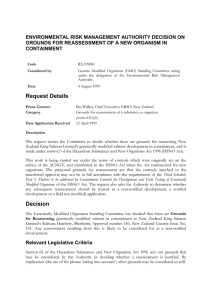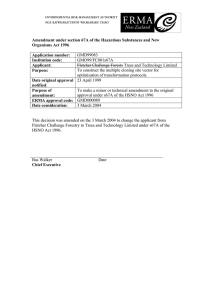ENVIRONMENTAL RISK MANAGEMENT AUTHORITY
advertisement
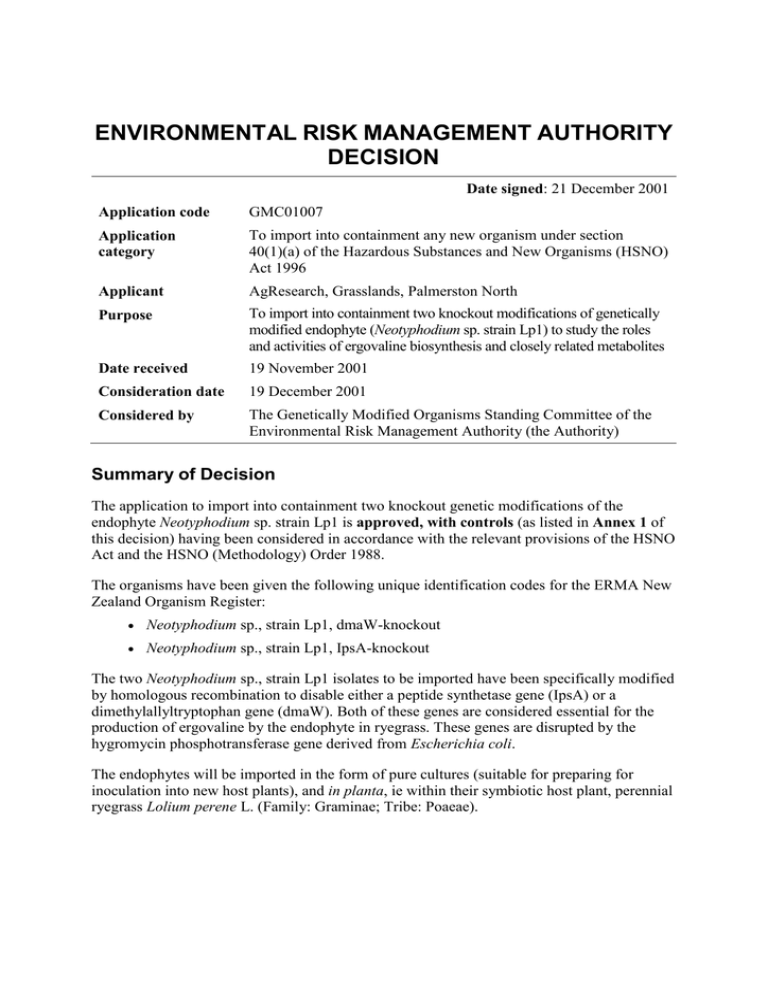
ENVIRONMENTAL RISK MANAGEMENT AUTHORITY DECISION Date signed: 21 December 2001 Application code GMC01007 Application category To import into containment any new organism under section 40(1)(a) of the Hazardous Substances and New Organisms (HSNO) Act 1996 Applicant AgResearch, Grasslands, Palmerston North Purpose To import into containment two knockout modifications of genetically modified endophyte (Neotyphodium sp. strain Lp1) to study the roles and activities of ergovaline biosynthesis and closely related metabolites Date received 19 November 2001 Consideration date 19 December 2001 Considered by The Genetically Modified Organisms Standing Committee of the Environmental Risk Management Authority (the Authority) Summary of Decision The application to import into containment two knockout genetic modifications of the endophyte Neotyphodium sp. strain Lp1 is approved, with controls (as listed in Annex 1 of this decision) having been considered in accordance with the relevant provisions of the HSNO Act and the HSNO (Methodology) Order 1988. The organisms have been given the following unique identification codes for the ERMA New Zealand Organism Register: Neotyphodium sp., strain Lp1, dmaW-knockout Neotyphodium sp., strain Lp1, IpsA-knockout The two Neotyphodium sp., strain Lp1 isolates to be imported have been specifically modified by homologous recombination to disable either a peptide synthetase gene (IpsA) or a dimethylallyltryptophan gene (dmaW). Both of these genes are considered essential for the production of ergovaline by the endophyte in ryegrass. These genes are disrupted by the hygromycin phosphotransferase gene derived from Escherichia coli. The endophytes will be imported in the form of pure cultures (suitable for preparing for inoculation into new host plants), and in planta, ie within their symbiotic host plant, perennial ryegrass Lolium perene L. (Family: Graminae; Tribe: Poaeae). Relevant Legislative Criteria The application was lodged pursuant to section 40(1)(a) of the HSNO Act. The decision was determined in accordance with section 45, taking into account additional matters to be considered under section 44, and matters relevant to the purpose of the Act, as specified under Part II of the HSNO Act. Unless otherwise stated, references to section numbers in this decision refer to sections of the HSNO Act. Consideration of the application followed the relevant provisions of the Hazardous Substances and New Organisms (Methodology) Order 1998 (the Methodology), as specified in more detail below. Unless otherwise stated, references to clause numbers in this decision refer to clauses of the Methodology. Application Process Application receipt The application was formally received 19 November 2001. The organisms are defined as low risk (category B) under the HSNO Low Risk Modifications Regulations 1998 and therefore application receipt was not publicly notified, according to ERMA New Zealand policy. In accordance with clauses 2(2)(e) and 5 of the Methodology and section 58(c) of the HSNO Act the Department of Conservation (DoC) and Ministry of Agriculture and Forestry (MAF) Biosecurity Authority were sent a copy of the application and provided comment for the consideration process. Information available for consideration An Evaluation and Review (E&R) Report was prepared by ERMA New Zealand to assist and support the Committee's decision-making. The E&R Report consolidated and evaluated the relevant information in a format and sequence consistent with the decision-making requirements of the HSNO Act and of the Methodology. Recognised techniques were used in identifying, assessing, and evaluating the relevant information, as required under clause 24 of the Methodology. Techniques for identifying and preparing information on risks, costs and benefits were based on internal procedures as specified in the ERMA New Zealand Technical Guide publications. The documents available for the evaluation and review of the application by ERMA New Zealand included the application; copies of key references cited in the application; copies of the Containment Manuals for the AgResearch Plant Molecular Genetics Laboratory and Glasshouse (Grasslands, Palmerston North site); and comments from the Department of Conservation. MAF Biosecurity Authority did not have any specific comments on this application. Decision making Committee The application was considered by the Genetically Modified Organism Standing Committee of the Authority, appointed in accordance with section 19(2)(b) of the HSNO Act. The Committee comprised the following members: Mrs Jill White (Chair), Mrs Helen Hughes and Ms Jane Lancaster. Environmental Risk Management Authority Decision: Application GMC01007 Page 2 of 12 Purpose of the Application The purpose of the application is to use the two knockout genetic modifications of Neotyphodium sp. strain Lp1, to study the comparative production of ergot alkaloids and related metabolites by the genetically modified and unmodified endophytes, to improve understanding of endophyte secondary metabolism, insect pest protection and risks of animal toxicosis. In accordance with section 45(1)(a)(i) of the HSNO Act, the Committee determined that the purpose was appropriate under section 39(1)(h): Such other purposes as the Authority thinks fit. Consideration approach and sequence In accordance with clause 24 of the Methodology, the approach adopted by the Committee was to look sequentially at identification, assessment and evaluation of risks, costs and benefits. The decision-making process is described in more detail in the following sections, with reference to legislative requirements under the HSNO Act and Methodology. Identification of the risks, costs and benefits The Committee conducted an identification of potential risks, costs and benefits related to the application, based on the requirements of the HSNO Act and the HSNO (Methodology) Order. Risks, costs and benefits were categorised in terms of their area of impact on: Environment Human health and safety Māori culture Economy Identification of risks The Committee recognised the following potential risks associated with the application in accordance with the Methodology clauses 9(a) and (c) (as specified in section 5 of the E&R Report): Risks to the environment Risks associated with horizontal gene transfer to other organisms (including hybridisation with other plant fungi). Risks associated with the importation of plant diseases with the live perennial ryegrass. Risks associated with development of endophytes with enhanced toxicity to grazing animals. Risks of enhanced weediness of perennial ryegrass infected with genetically modified endophytes. Environmental Risk Management Authority Decision: Application GMC01007 Page 3 of 12 Risks to human health and safety Risks to human health and safety, through allegenicity or toxicity of the genetically modified endophytes. Risks to Māori culture Risks to relationship of Māori and their culture and traditions with taonga associated with the importation and use of genetically modifed endophytes, including potential feeding trials involving native or valued fauna. Risks to the economy Refer to costs associated with the application, below. Identification of benefits and costs The Committee recognised the following potential benefits and costs associated with the application, in accordance with the Methodology clauses 9, 10, 13, and 14 and section 6(e) of the HSNO Act (as specified in section 7.4 of the E&R Report): Maintaining international standing and leadership in Neotyphodium endophyte research. The applicant’s ability to attract funding and indirect support, for example through international collaboration, for their research. Improved knowledge of the impact of ergovaline biosynthesis disruption upon other aspects of the endophyte-grass symbiosis. Development of endophytes with benefits for animal health and improved pasture productivity in New Zealand. Costs to the agricultural industry if perennial ryegrass containing the genetically modified endophytes escaped and established a self-sustaining population. Adequacy of the proposed containment In assessing risks, the adequacy of the containment regime was considered (section 45(1)(a)(iii) of the HSNO Act) in relation to the ability of the organisms to escape containment; form self-sustaining populations, and the ease of eradication of any such populations (sections 37 and 44). Risk management techniques were considered in relation to the identified risks (clause 24). Ability to escape containment The Committee considers that the organisms to be imported would, if developed in New Zealand, meet the characteristics of Category B experiments under the HSNO (Low-Risk Genetic Modification) Regulations 1998. Experiments are thus required to be conducted, and the genetically modified organisms contained, under Physical Containment Level 2 (PC2) laboratory and plant house conditions, as specified under the Australian/New Zealand Standard AS/NZS 2243.3:1995 Safety in Laboratories: Part 3: Microbiology (refer to Controls 1.1 and 1.2 in Annex 1 of this decision). Environmental Risk Management Authority Decision: Application GMC01007 Page 4 of 12 The Committee notes that the perennial ryegrass plants containing modified endophytes will be maintained in the AgResearch Plant Breeding and Genomics Containment Glasshouses in Palmerston North (MAF reference code 3255). These glasshouses are registered under joint MAF Biosecurity Authority/ERMA New Zealand Containment Standard 154.04.09 (plant house) and meet PC2 requirements. The Committee also notes that the modified endophytes will be cultured, manipulated, inoculated into ryegrass seedlings, harvested and extracted in the AgResearch Plant Molecular Genetics Laboratory in Palmerston North (MAF reference code 482). This laboratory is registered at PC2 under joint MAF Biosecurity Authority/ERMA New Zealand Containment Standards 154.02.17 (transitional facilities for biological products), and 154.03.02 (microorganisms). The Committee notes that procedures are set out to prevent accidental removal of plant material outside the glasshouse on personal clothing, in AgResearch's glasshouse containment manual. However, the Committee notes the absence of specific reference to accidental removal of genetically modified material on clothing, in AgResearch's microorganism facility containment manual. The Committee has added, therefore, an additional control to reduce the risk of accidental removal from containment on clothing of seeds or other plant material containing modified endophytes (refer to Control 1.8, Annex 1 of this decision). Additional Controls 1.3 to 1.7 inclusive (refer to Annex 1 of this decision) relate to plant handling practices and are also intended to reduce risks of escape from containment of genetically modified material. The applicant signalled an intention to evaluate the effects of genetic modifications on plants in feeding trials involving contained insects and other invertebrate microfauna (such as mites and nematodes). However, the applicant states that the detail of these trials is yet to be defined. In the absence from the application of a description of the feeding trials, the Committee imposes an additional control requiring details of the feeding trials to be approved by the Authority before the trials commence (refer to Control 1.9, Annex 1 of this decision). The Committee also imposes other additional controls to minimise risks of escape of genetically modified material from containment during, or as a consequence of feeding trials, should the feeding trials be conducted (refer to Controls 1.10 to 1.12, Annex 1 of this decision). Furthermore, the Committee excludes native invertebrates and all vertebrates (ie native or exotic) from use in any feeding trials. Should the applicant wish to include such organisms in feeding trials, a Grounds for Reassessment request (under section 62(1) of the HSNO Act) would need to be submitted to ERMA New Zealand, and any consequent Reassessment application (under section 63(1) of the HSNO Act) approved by the Authority (refer to additional Controls 1.13 and 1.14, Annex 1 of this decision). The Committee considers that with the containment controls it has imposed (refer to Annex 1 of this decision), it is very unlikely for viable genetically modified endophyte (including seeds or plants containing endophyte) to escape or be removed inadvertently from containment. The Committee requires the applicant to submit a report to ERMA New Zealand, by 31 December 2004, describing any unanticipated adverse effects associated with the genetically modified endophytes (refer to additional Control 8.2, Annex 1 of this decision). Environmental Risk Management Authority Decision: Application GMC01007 Page 5 of 12 Ability of the organisms to establish an undesirable self-sustaining population and ease of eradication In accordance with sections 44 and 37 of the HSNO Act, the Authority considered the ability of the organisms to establish undesirable self-sustaining populations, should they escape from containment, and the ease with which such populations could be eradicated. In evaluating these matters the Committee took into account the nature of the organisms (clause 22 of the Methodology). The Committee concurs with the E&R Report (section 6.21), that if the modified endophyte material alone escaped, it is very unlikely to survive in nature, and very unlikely to infect suitable host plants and establish a self-sustaining population. If viable plant material containing viable modified endophyte escaped, then it may be equally likely or unlikely for plants containing the endophyte to establish, depending on whether or not the viable plant material settles in a location suitable for establishment. The magnitude of the effects would be minimal or minor, as any increased adverse effects on livestock or increased weedy ability would be likely to be able to be rapidly noticed and infected patches of grass could be removed or destroyed. However, the Committee also noted that if seeds or viable plant material established then it is likely that it would not be able to be detected if no adverse effects occurred or loss from containment was not noticed. Therefore, the containment controls associated with this approval are to ensure that inadvertent loss of material from containment is very unlikely. Assessment of risks The Committee concluded that taking into account the containment controls imposed in this decision, the application poses negligible risks. In reaching this conclusion, the Committee gave particular regard (under clauses 9, 10 and 12 of the Methodology) to: Risks to the environment The Committee considers that it is very unlikely that adverse environmental effects would result from having the genetically modified endophytes in containment (based on the assessment provided in section 7.1 of the E&R Report). It is expected that the modified endophytes would exhibit less toxicity than the unmodified parental strains, although there is uncertainty associated with this because the effect of disruption in the metabolic pathway has not yet been well studied. The work proposed by the applicant would reduce this uncertainty. The Committee also noted the expectation of the applicant that plants containing modified endophyte with reduced insect feeding ability may be less able to establish and so be very unlikely to have increased weediness. The Committee considers that there is uncertainty associated with this, but that research proposed by the applicant will reduce this uncertainty, and so long as the plant material infected with the endophyte remains in containment it is very unlikely for adverse effects on the environment due to altered weedy potential to occur. It is also considered very unlikely, due to the controlled and contained nature of the experiments that escape from containment and/or adverse effects on the environment would result from horizontal gene transfer since both fungal, plant, and animal material is to be contained at all times, and viable genetically modified material destroyed when no longer required. Environmental Risk Management Authority Decision: Application GMC01007 Page 6 of 12 The Committee considered the potential for importation of plant diseases when plant material containing the genetically modified endophyte is imported. As required under the Biosecurity Act normal phytosanitary and quarantine procedures are required during importation. As such the Committee considers that the risks associated with importation of plants containing genetically modified endophyte are very unlikely to be different from those associated with importation of other viable plant or fungal material. The Committee considers it unlikely that adverse effects on native or valued flora and fauna would occur if the modified endophytes established outside containment, although there will be uncertainty associated with this until the effects of the modified ryegrass endophytes are tested by the proposed research. As noted above, increased adverse effects on livestock are likely to be able to be rapidly detected and infected plants could be removed or destroyed. Therefore the Committee considers that the magnitude of any adverse effects on native or valued flora and fauna would be minimal or minor in the event of escape from containment. Risks to human health and safety The Committee considers that it is very unlikely that the import and use of genetically modified endophytes would have any adverse effects on human health and safety (based on the assessment provided in section 7.2 of the E&R Report). In the very unlikely event that adverse effects were realised, they would probably be local (ie limited to research staff) and treatable, so that the magnitude of effect would be minimal. Risks to Māori culture The Committee considers the import and use of the genetically modified endophytes is very unlikely to have any adverse effects on Māori and their taonga (based on the assessment provided in section 7.3 of the E&R Report). The Committee notes that feeding trials involving insects and other invertebrate microfauna may be conducted in the future (refer to E&R Report sections 6.10 and 6.11). The Committee considers that if native invertebrates (such as grass grub beetles or larvae) are to be used in feeding studies, the applicant should consult with local hapu on this issue during the research planning stage. As noted above, the Committee considers that native invertebrates should be excluded from any approval given at this stage. Consequently, if the applicant wishes to include native invertebrates in any future feeding trials, a Grounds for Reassessment request would need to be submitted to ERMA New Zealand (refer to additional Control 1.13, Annex 1 of this decision). It would be appropriate to provide results of consultation with local Māori groups in any application for reassessment. Similarly, a Grounds for Reassessment request would be required for any proposed feeding trials that involve either native or exotic vertebrates (refer to Control 1.14, Annex 1 of this decision). Environmental Risk Management Authority Decision: Application GMC01007 Page 7 of 12 Assessment of benefits and costs Benefits1 that may arise from the application (regarding matters set out in clauses 9 and 10 of the Methodology) were assessed and considered in terms of clauses 13 and 14. The Committee concurs with the assessment provided in section 7.4 of the E&R Report, that the primary benefit of the importation of the genetically modified endophytes is likely to be the increase in scientific knowledge (non-monetary). An objective of the research is to improve knowledge of the impact of ergovaline biosynthesis disruption upon other aspects of the endophyte-grass symbiosis. Longer-term objectives include development of improved endophyte strains, which the applicant states could have major benefits for animal health and improved pasture productivity in New Zealand. The Committee notes the uncertain nature of such potential long-term benefits. The Committee considers that economic costs in the event of escape of the genetically modified material are very unlikely and would have minimal or minor impacts, based on the assessment provided in sections 7.1 and 7.4 of the E&R Report. The Committee considers that the primary benefits associated with this application are likely to be non-monetary and that no additional costs2 are likely to be imposed on third parties. Overall evaluation of risks, costs and benefits In accordance with clauses 21 and 36(2)(b) of the Methodology, the Committee records that the following criteria in the HSNO Act and Methodology have been particularly relied on: 1 The Committee has considered the application in the context of the purpose and principles of the HSNO Act (sections 4 - 8 inclusive of the HSNO Act). 2 Pursuant to section 45(1)(a)(i) of the HSNO Act, the Committee is satisfied that this application is for one of the purposes specified in section 39(1) of the Act, being section 39(1)(h): Such other purposes the Authority sees fit. 3 In evaluating risks, costs and benefits the following information has been taken into account (in accordance with clause 22 of the Methodology): (i) the nature and characteristics of the organism, (ii) the applicant's assessments and risk management proposals, and (iii) the Evaluation and Review (E&R) Report provided for ERMA New Zealand (which was collated using a recognised risk management process in accordance with clause 24 of the Methodology). 4 The Committee has recognised and taken into account hazards and areas of impact as listed in clauses 9 and 10 of the Methodology, particularly in relation to evaluating adverse and beneficial effects on the environment, human health, economy and Māori culture. 5 The Committee has taken into account the characteristics of risks, costs and benefits in accordance with clauses 12, 13 and 34 of the Methodology, particularly in relation to the nature, likelihood, magnitude and spread of adverse and beneficial effects. A “benefit” is defined in regulation 2 of the Methodology Order as “the value of a particular positive effect expressed in monetary or non-monetary terms”. 1 A “cost” is defined in regulation 2 of the Methodology Order as “the value of a particular adverse effect expressed in monetary or non-monetary terms”. 2 Environmental Risk Management Authority Decision: Application GMC01007 Page 8 of 12 6 The degree of uncertainty attached to scientific evidence relating to risks has been considered in accordance with clause 25 of the Methodology. 7 In its approach to risk, the Committee had regard to the risk characteristics set down in clause 33 of the Methodology, and concluded that none of the characteristics listed in clause 33(a) – (e) applied to this application. 8 The Committee is satisfied that the organisms can be adequately contained (sections 45(1)(a)(iii) and 44(b) of the HSNO Act), under the controls required by this decision (refer to Annex 1). In relation to the additional matters to be considered under section 37 of the HSNO Act, the Committee considers that it is very unlikely for viable genetically modified endophyte (including seeds or plants containing endophyte) to escape or be removed inadvertently from containment and form a self-sustaining population. However, the Committee notes that eradication, while technically feasible, would depend on the ability to detect any breach of containment and the subsequent location of any selfsustaining population. 9 The Committee has formed the view that risks associated with the application are negligible. In noting the above conclusion that the organisms can be adequately contained under the controls required by this decision, the Committee considers the benefits associated with the importation and use of the organisms in containment outweigh the costs. The Committee has therefore considered this application in terms of clause 26 of the Methodology. In reaching this conclusion, the Committee considered all the possible beneficial and adverse effects of the organisms (and any inseparable organisms) in accordance with sections 45(1)(a)(ii) and (iii) of the HSNO Act. Decision The application for importation into containment of two knockout modifications of genetically modified endophyte (Neotyphodium sp. strain Lp1) is thus approved in accordance with section 45(a) of the HSNO Act. As required under section 45(2) the approval is subject to controls (as listed in Annex 1 of this decision). The Committee accepts the advice from ERMA New Zealand (refer to E&R Report, section 6.18) that it would be appropriate to impose a three-year time limit on this approval. Accordingly, approval to import, in terms of this decision, is valid until 31 December 2004 (refer to additional Control 8.1, Annex 1). Mrs Jill White Chair, Decision-making Committee of the Authority Environmental Risk Management Authority Decision: Application GMC01007 Date Page 9 of 12 Annex 1: Controls required by this approval In order to satisfactorily address the matters detailed in the Third Schedule Part I: Containment controls for importing, developing or field testing of genetically modified organisms3 of the HSNO Act, and other matters in order to give effect to the purpose of the HSNO Act (section 45(2)), the Authority’s approval of this application is subject to the following controls: 1 To limit the likelihood of any accidental release of any organism or any viable genetic material4: 1.1 The person responsible for a particular research area and/or the person responsible for the operation of the containment facility shall inform all personnel involved in the handling of the organisms of the Authority’s controls. 1.2 The containment facility in which the organisms are maintained shall be registered by the Ministry of Agriculture and Forestry (MAF) Biosecurity Authority in accordance with the MAF Biosecurity Authority/ERMA New Zealand Standard 154.03.02 (Containment Facilities for Microorganisms), at microorganism Physical Containment Level 2 (PC2); and MAF/ERMA New Zealand Standard 155.04.09 (Containment Facilities for New organisms (including genetically modified organisms) of plant species), at plant house Physical Containment Level 2 (PC2), and the additional controls of the Authority. The construction and operation of the containment facilities (‘the facility’) in which the organisms are maintained, shall be in accordance with the relevant standards listed above. Additional controls relating to plant handling: 1.3 Plants containing the genetically modified endophytes shall be clearly labelled. 1.4 All plants containing genetically modified endophyte shall be monitored weekly during the flowering season to check for development of reproductive structures. 1.5 Prior to flower maturation the reproductive structures shall be removed or the plants or reproductive structures securely covered with an appropriate material to ensure that escape of pollen and seeds does not occur. 1.6 Seeds and other plant material required for further analysis shall be collected and securely stored and transported in sealed containers. 1.7 Soil, containers or dishes in which plants containing genetically modified endophytes are grown, and surfaces which may have been exposed to seeds or plants containing modified endophytes shall be sterilised after use. 1.8 Laboratory coats without pockets are to be worn by all people within containment facilities containing genetically modified endophytes. These coats are to be removed and left within the containment area by people leaving the containment facilities. 3 Bold headings refer to Matters to be Addressed by Containment Controls for Development and Field Testing of Genetically Modified Organisms, specified in the Third Schedule of the HSNO Act 1996. 4 Viable Genetic Material is biological material that can be resuscitated to grow into tissues or organisms. It can be defined to mean biological material capable of growth even though resuscitation procedures may be required, e.g. when organisms or parts thereof are sublethally damaged by being frozen, dried, heated, or affected by chemical. Environmental Risk Management Authority Decision: Application GMC01007 Page 10 of 12 Additional controls relating to invertebrate feeding trials: 1.9 Procedures to be followed in invertebrate feeding trails, including identity and numbers of invertebrates to be used, shall be submitted to ERMA New Zealand. Any such trials cannot commence without written approval from the Authority (refer also to control 1.13 regarding native invertebrates). 1.10 In the event that invertebrate feeding trials are conducted on the genetically modified material: the test invertebrates, genetically modified fungi, and plant material containing genetically modified fungi shall be securely contained in registered containment facilities [154.03.02 (microorganism) or 155.04.09 (plant house)] in an appropriate manner such that the organisms are unable to escape. 1.11 After the feeding trials, invertebrates shall be released or disposed of in such a manner that prevents release of viable genetically modified endophyte from containment. This shall include a prohibition on removing live invertebrates from the containment facility until they have spent at least 24 hours on a diet of non-genetically modified food. 1.12 All biological material no longer required (including unused/uneaten endophyte and endophyte-infected plant material) shall be disposed of by autoclaving or incineration on site. 1.13 Native invertebrates are excluded from use in any feeding trials involving genetically modified material associated with this approval. In the event that the applicant wishes to include native invertebrates in feeding trials, a Grounds for Reassessment request would need to be submitted to ERMA New Zealand (under section 62(1) of the HSNO Act) seeking such approval. 1.14 Vertebrates are excluded from use in any feeding trials involving genetically modified material associated with this approval. In the event that the applicant wishes to include vertebrates in feeding trials, a Grounds for Reassessment request would need to be submitted to ERMA New Zealand (under section 62(1) of the HSNO Act) seeking such approval. 2 To exclude unauthorised people from the facility: 2.1 Construction and operation of the containment facility shall comply with the requirements of the standards listed in control 1.2 relating to the identification of entrances, numbers of and access to entrances and security requirements for the entrances and the facility. 3 To exclude other organisms from the facility and to control undesirable and unwanted organisms within the facility: 3.1 Construction and operation of the containment facility shall comply with the requirements of the standards listed in control 1.2 relating to the exclusion of other organisms from the facility and the control of undesirable and unwanted organisms within the facility. 4 To prevent unintended release of the organism by experimenters working with the organism: 4.1 Construction and operation of the containment facility shall comply with the requirements of the standards listed in control 1.2 relating to the prevention of unintended release of the organisms by experimenters working with the organisms. Environmental Risk Management Authority Decision: Application GMC01007 Page 11 of 12 5 To control the effects of any accidental release or escape of an organism: 5.1 Construction and operation of the containment facility shall comply with the requirements of the standards listed in control 1.2 relating to controlling the effects of any accidental release or escape of an organism. 5.1 If for any reason a breach of containment occurs, the facility Supervisor5, MAF Biosecurity Authority and ERMA New Zealand shall be notified immediately the event is noticed (and at least within 24 hours of the breach being detected). 5.2 In the event of any breach of containment of the organisms, the contingency plan for the attempted retrieval or destruction of any viable material of the organism that has escaped shall be implemented immediately. The contingency plan shall be included in the containment manual in accordance with the requirements of standards listed in control 1.2. 6 Inspection and monitoring requirements for containment facilities: 6.1 The operation of the containment facilities shall comply with the requirements contained in the standards listed in control 1.2 relating to the inspection and monitoring requirements for containment facilities. 6.2 The Authority, or its authorised agent or properly authorised enforcement officers, may inspect the facilities at any reasonable time. 6.3 The containment manual shall be updated, as necessary, to address the implementation of the controls imposed by this approval, in accordance with the Standards listed in control 1.2. 7 Qualifications required of the persons responsible for implementing those controls: 7.1 The training of personnel working in the facility shall be in compliance with the standards listed in control 1.2. 8 Other matters: Additional controls: 8.1 This import approval is valid until 31 December 2004. At this time, any genetically modified endophyte material already imported can continue to be held in containment under the controls specified in this approval. 8.2 On, or before, 31 December 2004 a report shall be submitted to ERMA New Zealand by the applicant, describing whether or not any unanticipated adverse effects associated with the genetically modified endophytes were observed. Any such effects shall be described along with inferences about their cause and any actions taken to manage the adverse effects. 5 An inspector appointed under the Biosecurity Act. Environmental Risk Management Authority Decision: Application GMC01007 Page 12 of 12
